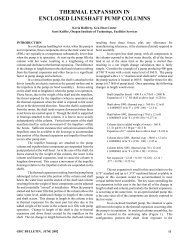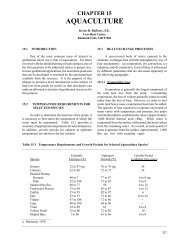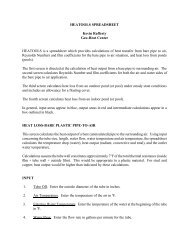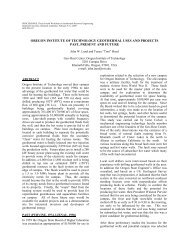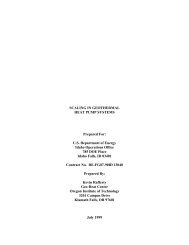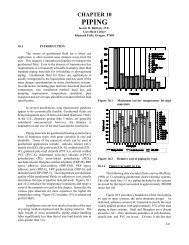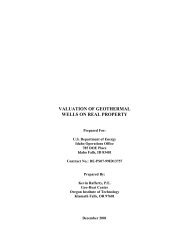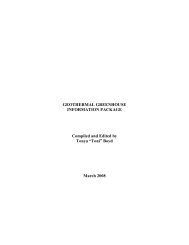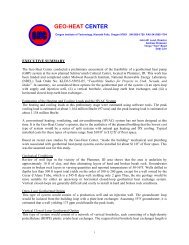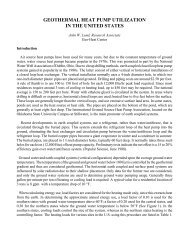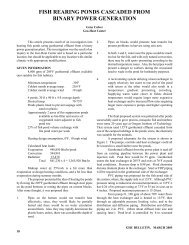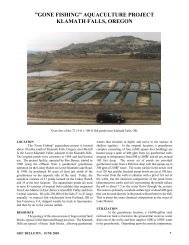Corrosion in Low-Temperature Geothermal Applications - Geo-Heat ...
Corrosion in Low-Temperature Geothermal Applications - Geo-Heat ...
Corrosion in Low-Temperature Geothermal Applications - Geo-Heat ...
Create successful ePaper yourself
Turn your PDF publications into a flip-book with our unique Google optimized e-Paper software.
The follow<strong>in</strong>g paper was published <strong>in</strong> ASHRAE Transactions (Vol.<br />
#91, Part 2B). Copyright 1985 American Society of <strong>Heat</strong><strong>in</strong>g,<br />
Refrigerat<strong>in</strong>g and Air-Condition<strong>in</strong>g Eng<strong>in</strong>eers, Inc.<br />
This post<strong>in</strong>g is by permission of ASHRAE, and is presented for<br />
educational purposes only. ASHRAE does not endorse or<br />
recommend commercial products or services.<br />
This article may not be copied and/or distributed electronically or <strong>in</strong><br />
paper form without permission of ASHRAE. Contact ASHRAE at<br />
www.ashrae.org.
Values for the Ryznar Stabil ityIndex are calculated as follows:<br />
Stabil ity Index'" 2pHs - pH<br />
pHs '" calculated pH of saturation of calcium carbonate<br />
pH '" pH from test of well water<br />
Table 1 <strong>in</strong>dicates the values of these <strong>in</strong>dices with respect to scal<strong>in</strong>g and corrosion. In<br />
general, Ryznar stability <strong>in</strong>dices between six and seven are desirable along with Langelier<br />
<strong>in</strong>dices of 0.0 plus or m<strong>in</strong>us 0.25. As can be seen, both <strong>in</strong>dices give a subjective tendency for<br />
the corrosion or scal<strong>in</strong>g performance of the water.<br />
It is critical to be aware, however, that these <strong>in</strong>dices are based primarily upon the<br />
solubility of calcium carbonate. As a result, the values do not consider other sources of<br />
scal <strong>in</strong>g, corrosion, and foul <strong>in</strong>g, such as dissol ved g
MAIN ENVIRONMENTAL<br />
FACTORS<br />
Oxygen<br />
Hydrogen Ion<br />
(pH)<br />
Chloride Ion<br />
TABLE 2.<br />
Ma<strong>in</strong> Environmental Factors And Effects on Materials<br />
MATERIAL<br />
Mild and low alloy steels<br />
Sta<strong>in</strong>less steels<br />
Titanium alloys<br />
Mild and low alloy steels<br />
Sta<strong>in</strong>less steels<br />
Titani urn alloys<br />
Copper alloys<br />
Mild and low alloy steels<br />
88<br />
EFFECT<br />
Uniform corrosion<br />
Pitt<strong>in</strong>g and crevice<br />
corrosion<br />
Fatigue<br />
1 imi ts<br />
endurance<br />
Stress corrosion<br />
crack<strong>in</strong>g<br />
Pitt<strong>in</strong>g and crevice<br />
corrosion<br />
Uniform and<br />
localized corrosion<br />
Uniform corrosion<br />
Stress corrosion<br />
crack<strong>in</strong>g<br />
Sulphide stress<br />
crack<strong>in</strong>g<br />
Pitt<strong>in</strong>g and crevice<br />
corrosion<br />
Stress corrosion<br />
crack<strong>in</strong>g<br />
Pitt<strong>in</strong>g and crevice<br />
corrosion '<br />
Stress corrosion<br />
crack<strong>in</strong>g<br />
Uniform pitt<strong>in</strong>g and<br />
crevice corrosion<br />
Stress corrosion<br />
crack<strong>in</strong>g<br />
Sulphide stress crack<strong>in</strong>g<br />
Uniform and<br />
localized corrosion<br />
<strong>in</strong> geothermal steam
MAIN ENVIRONMENTAL<br />
FACTORS<br />
Ammonia<br />
Sul fate ion<br />
Transi ti on metal<br />
ions<br />
<strong>Temperature</strong><br />
Flow velocity<br />
TABLE 2. (Cont<strong>in</strong>ued)<br />
MATERIAL<br />
Mild and low alloy steels<br />
Sta<strong>in</strong>less steels<br />
Copper alloys<br />
Mild and low alloy steels<br />
Sta<strong>in</strong>less steels<br />
A 1 umi num alloys<br />
Mild and low alloy steels<br />
Sta<strong>in</strong>less steels<br />
Titanium alloys<br />
Mild and low alloy steels<br />
Sta<strong>in</strong>less steels<br />
Nickel alloys<br />
90<br />
EFFECT<br />
Uniform corrosion<br />
Uniform pitt<strong>in</strong>g and<br />
crevice corrosion<br />
Stress corrosion<br />
crack i ng, "season<br />
crack<strong>in</strong>g"<br />
uniform pitt<strong>in</strong>g and<br />
crevice corrosion<br />
Pitt<strong>in</strong>g<br />
Pitt<strong>in</strong>g and crevice<br />
corrosion<br />
Uniform pitt<strong>in</strong>g and<br />
crevice corrosion<br />
Sulphide stress crack<strong>in</strong>g<br />
Pitt<strong>in</strong>g and crevice<br />
corrosion<br />
Stress corrosion<br />
crack<strong>in</strong>g<br />
Pitt<strong>in</strong>g and crevice<br />
corrosion<br />
Genera 1 effects<br />
Genera 1 effects<br />
Applicabiltty <strong>in</strong><br />
high flow rates



